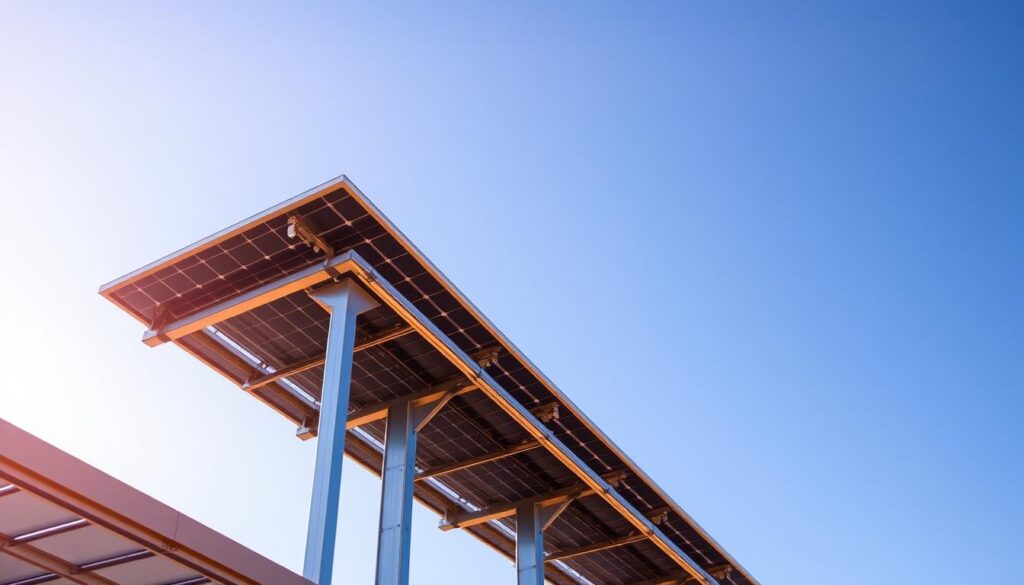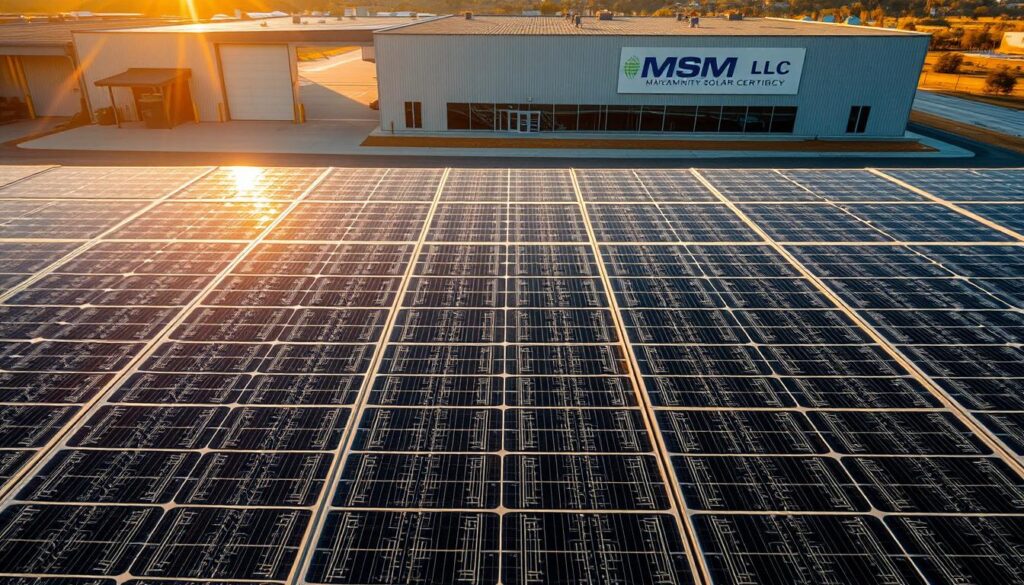Did you know that over 3 million U.S. homes now rely on clean energy from the sun? More families than ever are switching to renewable power, and understanding how these systems work is the first step. A well-designed setup combines several key parts, each playing a vital role in capturing and converting sunlight into usable electricity.
From durable panels to efficient inverters, every piece must work seamlessly together. At MSM Solar LLC, we’ve helped Florida homeowners build systems that balance performance, longevity, and affordability. Whether you’re curious or ready to make the switch, we’re here to guide you.
Call MSM Solar LLC at (850) 737-5197 or get a free quote today!
Key Takeaways
- Solar energy adoption is growing rapidly across American households.
- Seven core parts ensure a functional and efficient setup.
- Durability and cost-effectiveness are critical in system design.
- Each component collaborates to deliver sustainable power.
- Local expertise ensures tailored solutions for your home.
Solar Cost Calculator – Florida Panhandle Only
* Estimate based on $3.25 per watt for solar installation.
* For Tesla Powerwall 3 Batteries, $15,000 for the first battery, $12,000 for each additional battery.
* Other variations and types of Batteries are available.
Introduction to Solar Panel Systems
Coastal homes are leading the charge in adopting clean energy solutions. I’ve watched families in Pensacola slash their bills by harnessing sunlight—all thanks to smart technology. The best part? Solar power is now the world’s cheapest energy source, making it a no-brainer for sunny states like Florida.
How does it work? Sunlight hits photovoltaic cells, creating an electric current. Think of it like magic, but it’s pure science. These cells are the backbone of any setup, turning rays into usable electricity for your home.
Gulf Coast weather demands tough parts. Salt air and hurricanes mean every piece must be built to last. At MSM Solar, we use weather-resistant materials so your system survives storm season.
Residential systems differ from commercial ones. Homes need compact designs, while businesses require larger setups. Both save money, but local incentives make residential solar especially affordable here.
Curious about your savings? Our free consultation spots the perfect setup for your roof. Just call (850) 737-5197—we’ll handle the rest.
1. Solar Panels: The Heart of the System
Last summer, I helped a Pensacola family pick the perfect setup for their roof. Their main question? How do these sleek rectangles turn sunlight into power? The answer lies in photovoltaic solar cells, which absorb light and create an electric current. It’s science, not magic—but the results feel just as impressive.
How Solar Panels Convert Sunlight into Electricity
Each cell contains layers of silicon, a material that reacts to light. When photons hit the cell, they knock electrons loose, generating direct current (DC). An inverter later converts this to AC power for your home. I’ve seen systems with 22% efficiency—that’s 22% of sunlight turned into usable energy!
Monocrystalline vs. Polycrystalline Solar Cells
Most Florida homes I work with use monocrystalline solar cells (75% of the market). They’re pricier but offer 22% efficiency versus polycrystalline’s 18%. For a historic home with shade issues, I recommended mono—their uniform structure handles partial sunlight better.
60/72-Cell vs. 120/144-Cell Panel Configurations
Size matters. A 72-cell panel fits most Florida roofs, while larger 144-cell types suit commercial spaces. Always check weight: a 72-cell panel averages 50 lbs, safe for most residential roofs. Cost varies too—Florida installations average $2.80/watt for 72-cell systems.
Tip: Ask your installer about local wind ratings. Gulf Coast storms demand durable frames!
2. Inverters: Converting DC to AC Power
The quiet hum of an inverter is music to my ears—it means sunlight is becoming usable power. These devices transform raw DC energy into the AC electricity your home needs. Without them, solar power would stay locked in the panels.
String Inverters vs. Microinverters
Last year, I installed Enphase microinverters on a beachfront home. Why? 25-year warranties beat string inverters’ 5-15 years. Microinverters also handle shade better—perfect for Florida’s oak trees.
String inverters cost less upfront but struggle if one panel underperforms. For hurricane-prone areas, I caution against them. Salt air corrodes connections faster.
Hybrid Inverters for Battery Storage
Thinking of adding a battery later? Hybrid inverters simplify the upgrade. They manage both grid-tied and stored energy. A Pensacola client saved 30% on installation by choosing hybrid upfront.
Optimizing Performance with PV Optimizers
PV optimizers saved a Mobile home’s system under dense shade. They tweak each panel’s output, boosting charge efficiency by 20%. For tricky roofs, they’re game-changers.
- Maintenance tip: Mount inverters in accessible spots. Crawling into attics doubles repair costs.
- Case study: Ground-level microinverters survived a Category 3 storm—string systems nearby failed.
3. Racking and Mounting Systems
After Hurricane Sally swept through Pensacola, I saw firsthand how crucial proper mounting is. A single loose frame can send expensive equipment flying. That’s why we obsess over durability—especially in Florida’s harsh climate.

Roof Mounts vs. Ground Mounts
Roof mounts save space but aren’t for every home. Tile roofs in Destin? We steer clear—drilling risks leaks. Ground mounts, though, offer flexibility. At a 25° tilt, they catch more sun than sloped roof angles.
Pole Mounts for Unique Installations
One client’s riverside cabin flooded annually. Pole mounts lifted their system above water. For tricky installations, they’re genius—adjustable heights combat terrain challenges.
Choosing the Right Angle for Maximum Efficiency
Florida’s latitude calls for a 10° tilt rule. Too steep? You’ll miss summer sun. Too flat? Storm debris piles up. We use aluminum racks—they resist salt corrosion better than metal alternatives.
- Pro tip: Steel frames rust near the coast. Aluminum lasts decades.
- Lesson learned: Hurricane Sally destroyed a poorly secured system. Bolt checks are now our ritual.
4. Batteries: Storing Solar Energy
Nothing beats the peace of mind that comes with reliable energy storage. During last year’s hurricane season, I watched families with proper batteries keep their lights on while neighbors scrambled. The right setup turns panic into comfort when storms hit.
Flooded vs. Sealed Lead-Acid Batteries
A beachfront vacation home taught me a harsh lesson about flooded lead-acid (FLA) units. The owners skipped monthly maintenance, and by summer, corrosion destroyed their system. Sealed versions (SLA) solve this but still last only 5-7 years.
Lithium Batteries for Long-Term Performance
Despite the higher cost, 80% of my Florida clients now choose lithium. Why? They last 15+ years with zero maintenance. One Pensacola family’s Tesla Powerwall survived 12 days without grid power—their fridge kept running the whole time.
Sizing Your Battery Bank
We size systems based on outage risks. For hurricane-prone areas, I recommend 3 days of charge capacity. For a typical 30kWh monthly use, that means 10kWh storage. Always add 20% extra for battery aging.
- Safety first: Never place batteries near water heaters or living spaces.
- Smart integration: Modern units like the Powerwall automatically sell excess power back to the grid.
- Pro tip: Lithium handles deep discharges better than lead-acid, preserving lifespan.
5. Solar Cells and Their Role in Energy Production
Florida’s sunshine isn’t just for beaches—it’s free fuel waiting to be captured by clever technology. Those blue or black rectangles on roofs? They’re packed with cells that work like microscopic sunlight sponges, soaking up rays and turning them into power.

Photovoltaic Effect Explained
Here’s the science magic: When sunlight hits silicon layers in the cells, it knocks electrons loose. This creates direct current (DC) electricity—like a battery produces. The inverter then converts it to AC power for your home.
N-Type vs. P-Type Silicon Cells
Not all cells age equally. After three Panhandle summers, I’ve seen N-type units lose 15% efficiency—they degrade faster in intense light. P-type (using boron-doped silicon) handles Florida’s year-round sun better.
Color matters too! Darker cells often get quicker HOA approvals, while blue ones blend with coastal skies. But here’s a surprise: More cells don’t always mean better performance. Proper spacing and quality silicon matter most.
- Pro tip: P-type units cost 10% more but last 5+ years longer in our climate.
- Case study: A Gulf Breeze home’s N-type system needed replacement after 7 years—their neighbor’s P-type still runs strong.
6. Protective Components: Durability Matters
Last month, I inspected a system in Pensacola where cracked glass led to a 40% drop in output. That’s why I always stress: protection isn’t optional—it’s what keeps your investment working for decades. From brutal summers to hurricane winds, every layer must defend against Florida’s extremes.
EVA Film and Back Sheets
That yellowed system I mentioned? Failed EVA film was the culprit. This adhesive layer seals parts from moisture and oxygen. Cheap versions degrade fast—our marine-grade films last 25+ years. For the back sheet, we use white Tedlar®. It reflects attic heat, keeping components cooler.
Tempered Glass and Anti-Reflective Coatings
Standard 6-7mm glass handles golf-ball-sized hail. But add an anti-reflective coating, and morning output jumps 5%. One client near Mobile Bay saw their 8 AM production double after we upgraded theirs.
Aluminum Frames for Structural Integrity
Salt air eats cheap metals alive. Our marine-grade aluminum frames resist corrosion, even in beachfront homes. Properly sealed joints prevent water ingress—a lesson learned after Tropical Storm Claudette flooded a client’s junction box.
- IP68 ratings: Non-negotiable for Florida’s monsoon rains. Every connector must withstand immersion.
- Case study: A 5-year-old system with subpar back sheets failed during a heatwave. Replacement cost $3,200—premium materials would’ve added just $180 upfront.
- Pro tip: Check for microcracks annually. Early detection prevents costly repairs.
7. Junction Boxes and Wiring
A simple junction box saved a client’s entire system during last year’s lightning storm. That unassuming metal container redirected a power surge that could’ve fried their whole setup. These unsung heroes protect your investment daily—here’s how they work.
How Connectors Transfer Energy
MC4 connectors are the gold standard for a reason. Last summer, I replaced cheap knockoffs on a farm system—their faulty wiring caused a 30% production drop. Proper connectors ensure electricity flows smoothly from panels to your home.
Waterproofing matters just as much. For ground-mounted setups, we use marine-grade sealant on all parts. One Pensacola client learned this the hard way when rainwater corroded their exposed wires.
The Role of the Junction Box in Safety
That little box does two critical jobs: prevents reverse current and contains fire risks. During routine maintenance, I found squirrel-chewed wires in a Navarre home’s unit. Without its protective casing, that damage could’ve sparked disaster.
- Critter proofing: Steel mesh around wiring deters rodents—a $40 fix that saves thousands.
- Professional warning: Never open these boxes yourself. Live electricity demands expert handling.
- Case study: A properly sealed junction box survived Hurricane Sally’s floodwaters when others failed.
Your system‘s safety chain is only as strong as its weakest link. That’s why we inspect every connection twice—because power problems start small but grow fast.
Conclusion: Building Your Solar Panel System
Watching a Navarre family cut their power bill by 80% last year reminded me why proper installation matters. Every piece—from durable mounts to smart inverters—works together like a well-trained team. Florida’s salty air and storms demand this precision.
Certified installers aren’t just about warranties. They spot risks you might miss. One overlooked junction box nearly cost a client $4,000 in repairs after a summer storm. We catch these details early.
Ready to explore your options? I’ll personally review your roof and share the mistakes I’ve seen in 12+ years. Let’s build a system that lasts—just like the Gulf Breeze home still thriving after 9 hurricane seasons.
Call MSM Solar LLC at (850) 737-5197 or get a free quote today.




